Related Research Articles

The archaeology of the Americas is the study of the archaeology of the Western Hemisphere, including North America (Mesoamerica), Central America, South America and the Caribbean. This includes the study of pre-historic/Pre-Columbian and historic indigenous American peoples, as well as historical archaeology of more recent eras, including the Trans-Atlantic slave trade and European colonization.

A potter's field, paupers' grave or common grave is a place for the burial of unknown, unclaimed or indigent people. "Potter's field" is of Biblical origin, referring to Akeldama, stated to have been purchased after Judas Iscariot's suicide by the chief priests of Jerusalem with the coins that had been paid to Judas for his identification of Jesus. The priests are stated to have acquired it for the burial of strangers, criminals, and the poor, the coins paid to Judas being considered blood money. Prior to Akeldama's use as a burial ground, it had been a site where potters collected high-quality, deeply red clay for the production of ceramics, thus the name potters' field.

Ward's Point is the southernmost point in the U.S. state of New York and lies within Tottenville, Staten Island, New York City. It is located at the mouth of Arthur Kill, across from Perth Amboy, New Jersey, at the head of Raritan Bay. The site is part of modern-day Conference House Park.
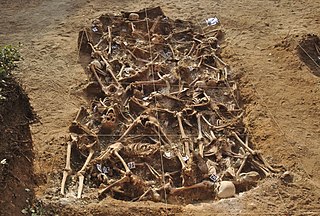
A mass grave is a grave containing multiple human corpses, which may or may not be identified prior to burial. The United Nations has defined a criminal mass grave as a burial site containing three or more victims of execution, although an exact definition is not unanimously agreed upon. Mass graves are usually created after many people die or are killed, and there is a desire to bury the corpses quickly for sanitation concerns. Although mass graves can be used during major conflicts such as war and crime, in modern times they may be used after a famine, epidemic, or natural disaster. In disasters, mass graves are used for infection and disease control. In such cases, there is often a breakdown of the social infrastructure that would enable proper identification and disposal of individual bodies.
The term bioarchaeology has been attributed to British archaeologist Grahame Clark who, in 1972, defined it as the study of animal and human bones from archaeological sites. Redefined in 1977 by Jane Buikstra, bioarchaeology in the United States now refers to the scientific study of human remains from archaeological sites, a discipline known in other countries as osteoarchaeology, osteology or palaeo-osteology. Compared to bioarchaeology, osteoarchaeology is the scientific study that solely focus on the human skeleton. The human skeleton is used to tell us about health, lifestyle, diet, mortality and physique of the past. Furthermore, palaeo-osteology is simply the study of ancient bones.

African Burial Ground National Monument is a monument at Duane Street and African Burial Ground Way in the Civic Center section of Lower Manhattan, New York City. Its main building is the Ted Weiss Federal Building at 290 Broadway. The site contains the remains of more than 419 Africans buried during the late 17th and 18th centuries in a portion of what was the largest colonial-era cemetery for people of African descent, some free, most enslaved. Historians estimate there may have been as many as 10,000–20,000 burials in what was called the Negroes Burial Ground in the 18th century. The five to six acre site's excavation and study was called "the most important historic urban archaeological project in the United States." The Burial Ground site is New York's earliest known African-American cemetery; studies show an estimated 15,000 African American people were buried here.

The Windover Archeological Site is a Middle Archaic archaeological site and National Historic Landmark in Brevard County near Titusville, Florida, United States on the central east coast of the state. Windover is a muck pond where skeletal remains of 168 individuals were found buried in the peat at the bottom of the pond. The skeletons were well preserved because of the peat. In addition, remarkably well-preserved brain tissue has been recovered from 91 skulls from the site. DNA from the brain tissue has been sequenced. The collection of human skeletal remains and artifacts recovered from Windover Pond represent among the largest finds of each type from the Archaic Period. It is considered one of the most important archeological sites ever excavated.
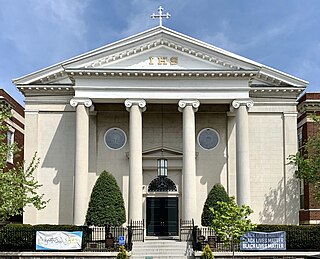
Holy Trinity Catholic Church is a Catholic church run by the Jesuit order that is located in the Georgetown neighborhood of Washington, D.C., in the United States. Holy Trinity Parish was founded in 1787 and is the oldest Roman Catholic community and house of worship in continuous operation both in Georgetown and in the larger city of Washington, D.C. The original church building was completed in 1794. It is now called the Chapel of St. Ignatius, and is used for smaller ecclesiastical celebrations and as an auxiliary space for parish activities. A larger church building, necessitated by the growing community, was dedicated in 1851, and still serves as the parish church today.

The location of the burial place of Genghis Khan has been the subject of much speculation and research. The site remains undiscovered, although it is generally believed that it is near the Mongol sacred mountain of Burkhan Khaldun in the Khentii Mountains.
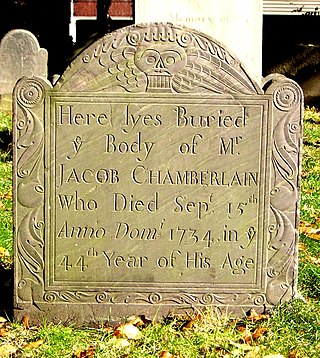
The Rumney Marsh Burying Ground is a historic cemetery on Butler Street between Elm and Bixby Streets in Revere, Massachusetts. It was added to the National Register of Historic Places in 2004. It was the first burying ground of an area that now encompasses Revere as well as neighboring Chelsea and Winthrop.
The year 2013 in archaeology involved some significant events.

The New Churchyard was a municipal and non-parochial burial ground in London. Established in 1569, it was used for burial from 1570 until 1739, by which date approximately 25,000 interments were estimated to have taken place. It was created to accommodate the ever-increasing number of new interments required as London's population expanded during 16th to 18th centuries. It was known as a "churchyard" despite not being associated with a church and, from the mid-17th century, became more commonly known as Bedlam or Bethlem burial ground because its location within the "Bedlam" or "Bethlem" area. The remains of the burial ground are now located under modern Liverpool Street, within the north-east corner of the City of London.
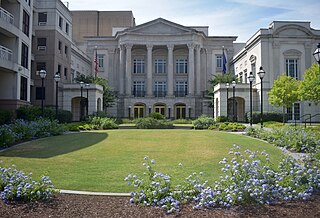
The Gaillard Center is a concert hall and performance venue in Charleston, South Carolina. It opened in 2015 and replaced the Gaillard Municipal Auditorium. Both buildings were named after John Palmer Gaillard Jr., mayor of Charleston from 1959 to 1975.
Bodzia Cemetery is a large 10th – 11th century chamber burial site in Bodzia, a town in the Kuyavia region of Central Poland, approximately 15 km to the northwest of Włocławek. A group from the Polish Academy of Sciences, led by Polish archaeologist, Andrzej Buko, excavated this site between 2007 – 2009. The excavation uncovered a large elite necropolis containing more than 58 graves, cenotaphs, weapons and riches. The Bodzia Cemetery is considered to be one of the most significant and "spectacular" Early Medieval findings in Poland in the last century. Artefacts uncovered in the site were mostly of foreign origin, which is atypical of other sites in the area. Information gleaned from the Bodzia Cemetery provided archaeologists with evidence of burial practices during the Early Medieval period in Poland.

The Portsmouth African Burying Ground is a memorial park on Chestnut Street in Portsmouth, New Hampshire, United States. The memorial park sits on top of an 18th century gravesite containing almost two hundred freed and enslaved African people. It is the only archeologically verified African burying ground for the time period in New England.
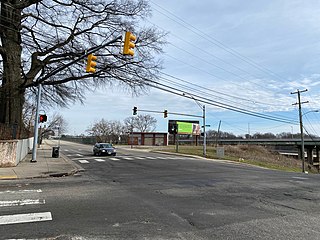
The Shockoe Hill African Burying Ground was established by the city of Richmond, Virginia, for the interment of free people of color, and the enslaved. The heart of this now invisible burying ground is located at 1305 N 5th St.
Newton Slave Burial Ground is an industrial heritage site and informal cemetery in Barbados. It was used by people enslaved at the adjacent Newton Plantation. The site has been owned by the Barbados Museum & Historical Society since 1993. It has been subject to excavations since the 1970s, which have produced information regarding slave lifeways including resistance, health, and culture.
Updown Girl is the name given to the skeletal remains of a young Anglo-Saxon girl discovered at an early 7th-century burial site close to Updown House in Eastry, Kent, England. Although first found in 1989, the Updown Girl aroused new interest in 2022 when modern analysis of her DNA indicated she had some West African ancestry, with evidence suggesting her paternal grandfather or possibly her great-grandfather came from either the Esan or Yoruba population groups.

The Godet African Burial Ground is an unmarked historical burial ground for enslaved African men, women and children located at the southwest coast of Sint Eustatius, Dutch Caribbean. The burial ground was part of the former Godet plantation on the island.

Golden Rock is the name of an archaeological site in the centre of the island of Sint Eustatius, Dutch Caribbean, named after a nearby former plantation. Golden Rock was the nickname of Sint Eustatius from its prominence as a major colonial trading port in the late 17th and early 18th century. The site contains the remains of a late Saladoid village, an African burial ground, and a village of enslaved Africans.
References
- 1 2 Stockwell, Amy (2023-02-23). "Professor's Research Helps Shed Light on 18th-Century African Remains Found at Gaillard Center". The College Today. Retrieved 2024-04-11.
- ↑ "Construction site unearths 27 graves". The Island Packet. 2013-02-16. p. 4. Retrieved 2024-04-11.
- ↑ "More graves discovered at building site". Sun-News. 2013-02-23. pp. C2. Retrieved 2024-04-11.
- 1 2 "Working of exhuming graves wrapping up". The Times and Democrat. 2013-03-03. p. 5. Retrieved 2024-04-12.
- ↑ Gutman, Caroline; Cochrane, Emily (2024-04-11). "Tracing Charleston's History of Slavery, From a Burial Ground to a DNA Swab". The New York Times. ISSN 0362-4331 . Retrieved 2024-04-11.
- ↑ Amy Stockwell, Professor’s Research Helps Shed Light on 18th-Century African Remains Found at Gaillard Center, and interview with Joanna Gilmore of College of Charleston about the DNA research
- ↑ Maddie Bender and Teddy Brokaw A New Project Uses Isotopes to Pinpoint the Birthplaces of the Enslaved, Smithsonian Magazine, January/February 2024
32°47′11″N79°55′53″W / 32.7863°N 79.9315°W